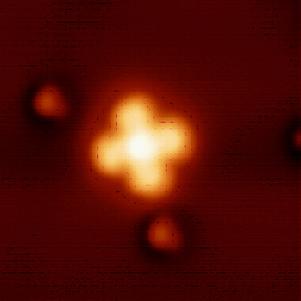Feynman’s Flowers is named after the Richard Feynman, who in his 1959 talk entitled “There’s plenty of room at the bottom” discussed what might happen if it were possible to manipulate matter at the atomic scale. “Flowers” refers to beautiful and distinctive four-petal shape of the phthalocyanine molecules when imaged with the scanning tunnelling microscope (STM).
Feynman’s Flowers allows volunteers to measure the position of a molecule in relation to a metal surface to help scientists understand how this can affect the molecule’s properties. Data that volunteers produce contributes to a research project run of University College London, Tsinghua University in Beijing and the Citizen Cyberscience Centre.
Currently, the research project is focused on exploring the behavior of phthalocyanine molecules. In the past, these were used as dyes for fabrics, but scientists now realize that they also have interesting electronic and magnetic properties that make them potentially useful for creating nanoscale devices that can manipulate or store information.
By measuring the way that the molecules bind to metal surfaces, the volunteers will help scientists to learn more about their magnetic properties and how these can be useful for making devices. For example, other studies have shown that the angle at which the molecules bind to the surface can significantly change how long a molecule can store a bit of information before it is erased.

Scanning tunneling microscope image of a magnetic molecule deposited on a metal surface. Volunteers will use the Feynman’s Flowers application to measure the angle of the molecule to help scientists understand how this can modify the molecules properties on the surface. Credit: UCL
Ben Warner, a PhD student at the London Centre for Nanotechnology (LCN), who is leading the analysis of the work, says, “Using individual molecules as circuit elements is the ultimate challenge in nanoscale science and engineering. Devices made this way could have a huge impact on society because they would store and process larger amounts of data in a smaller space using less energy. Through the development of this website, we are letting the general public directly participate in this exciting work.”
This website is the first project of its kind in this area of physics, applying the power of crowd-sourcing to help understand images created by a scanning tunneling microscope. Operating at temperatures close to absolute zero (-273˚C), the STM allows scientists to image individual atoms and molecules on surfaces and to explore their magnetic and electronic properties. Public participation will allow for the analysis of data in ways that previously would not have been possible.






Comments